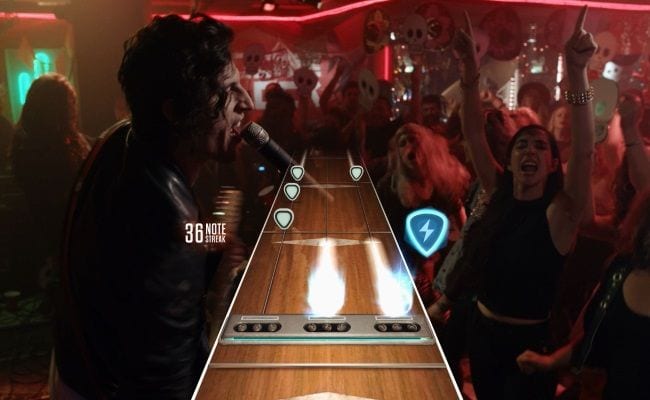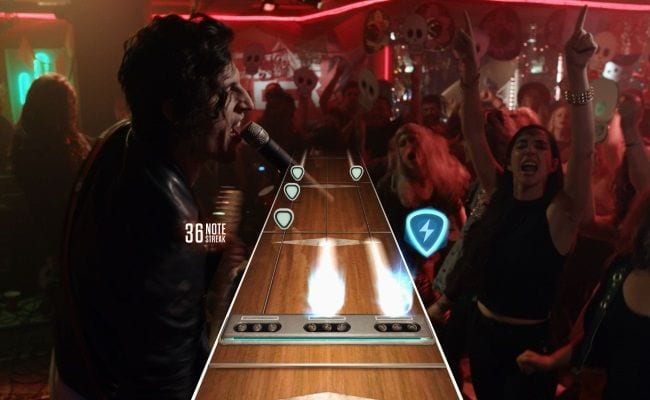
In the 80s, my grandfather used to rail against digital clocks. “These kids can’t even read a clock,” he would sigh in exasperation. He also railed against velcro shoes, “They won’t even know how to tie their shoes when they grow up!”
Some of this spirit of criticism was present during the heyday of the Guitar Hero and Rock Band series of rhythm game. Both series were madly popular in the mid to late 2000s, fairly universally adored as a party game, a communal experience of pretending that you and your friends were in a band.
The game’s harshest critics most often attacked the simplicity of the plastic instrumentation, arguing that the game’s false sense of musicianship was troubling. Yes, you could feel like a rock god, but the skills of playing a rhythm game on a plastic controller shaped like a guitar was no substitute for reality, for really learning how to play an instrument. Of course, in many ways, this was exactly the allure of Rock Band. It was all of the fantasy of playing a Van Halen riff with none of the work. But like wearing a digital watch as an adult or the idea of velcro shoes as a reasonable choice of footwear, the craze died down and the games stopped being cranked out on a more than yearly basis.
So, here we sit in the middle of a decade once again looking at a relaunch of what seems to have amounted to (for all but a few staunchly committed aficionados) a faddish video game genre, a rhythm game featuring a unique peripheral, that guitar-shaped plastic controller.
The trouble, of course, with launching or relaunching a game series with a unique peripheral is, well, that it is a game with a unique peripheral. Additional peripherals have never fared especially well on home consoles. From light guns to Nintendo’s R.O.B. the robot, peripherals require an investment from the consumer and from the hardware manufacturer. Buying an additional peripheral comes with an expectation that that peripheral will be worth the investment, be that in a commitment to producing more games that require that peripheral (which, of course, limits a developer’s and a publisher’s audience to only those who have invested in it) or that the game the peripheral is used for is going to see some significant amount of playtime. Both of which turned out to be the case for the original Guitar Hero and its expansion into additional peripherals (like drums, mics, and bass guitars) and, of course, Rock Band.
Lightning struck and two series that required additional investment beyond the game itself sold like gangbusters for a number of years. So, the questions lingering around the relaunch of the once very successful series remain familiar ones. Will investment in a new plastic guitar be worth it over time? Will lightning strike twice?
The relaunch of Guitar Hero comes with a remodel of the aforementioned peripheral, and in some sense, both questions probably hang on the acceptance of the alteration of the means of interacting with the game. In some way, the remodeling of the guitar does seem a kind of olive branch to the vocal minority of prior critics of Rock Band and Guitar Hero. This peripheral seems to be an effort to reinvigorate the series with a nod to a kind of authenticity.
Initially, this is evident in the appearance of the guitar itself, gone are the multicolored buttons on the neck of the guitar. In general, the guitar looks slicker, more authentic, more “professional.” The garish means of simulating playing across the guitar’s frets (those five colorful buttons) has been replaced by six buttons divided between three frets (that is, an upper button and a lower button on each of the highest frets on the guitar). These buttons blend visually with what looks more like the actual neck of a guitar.
Authenticity might not be the best way to accurately describe playing the guitar now (I imagine naysayers will continue to claim that this means of input still creates a false impression of the challenge of playing music), but playing the guitar in Guitar Hero Live is now more challenging than the older method.
Basically, the concept remains the same. The player holds down “notes” by matching symbols onscreen with the three positions on the guitar. Only now, sometimes you have to play the upper button in one of the positions or the lower one in that position or sometimes hold both (mimicking playing chords more accurately, more “authentically,” as it were).
In a nutshell, growing accustomed to playing the game is harder. And at least for me, more practice is required to learn how to play in general. To its credit, the way the game ramps up difficulty in the campaign is more sensible, gradually introducing new elements incrementally as songs grow increasingly more complicated to play. Once again, at least for me, in the previous iteration of the series, I found difficulty spikes to only occur when changing difficulty settings from Easy to Medium to Hard, etc. The difficulty spikes between these settings often stalled me out because they seemed to me to spike very, very steeply. Here, Easy Mode is pretty easy for two or three songs, then Easy become slightly more difficult for the next few, then a bit more tricky, then a bit more. I felt eased into play much more so than my first time out with a plastic guitar.
Having said that, I still think that the game is notably harder than it was before. Part of what made Guitar Hero and Rock Band so universally loved and an easy choice for a party game was its ease of entry, its lack of authenticity. Sure, some of the additional peripherals were harder to master (I still can’t play drums in either game with even the barest competency), but someone in the group was up for a challenge and those who weren’t, well, five colored buttons were pretty easy to match to a screen of similarly colored and located notes.
These games were digital watches, they were velcro, and that’s why everybody in the house, from the most casual to the most hardcore player, was pretty open to giving it a shot. By ramping up the challenge, the seeming authenticity of play, I’m no longer sure they will be so willing. Getting started is a bit more difficult now, especially if you just want to jump into any old song. You kind of need that easing in period before you feel confident enough to start just picking and choosing any song, no matter its difficulty.
To me, the audience for this game seems narrower, seems like those willing to commit more to learning how to play, than in merely stepping in for a quick jam session. Couple that with the fact that the game has been reduced to a more isolated playstyle with the “band” element of the game still absent at least at present (yes, the game is Guitar Hero Live, so you can compete with other players online, but not co-operate), and the great success of Guitar Hero as a social experience and as a casually accessible experience seems less likely to me with this entry in the series.
Aficionados will likely appreciate the challenge, but the broader audience that these games’ roped in seem less likely to get excited about this experience, as it lacks the social pleasure and the pleasure of a very low barrier to entry that the series previously had. That being said, while I wouldn’t say that I am by any stretch of the imagination a hardcore rhythm game player, I do like the genre and I do like a new challenge. I will continue to practice with the game, and I do find it fun in its own right. However, me and mine (my wife and daughters really enjoyed playing the earlier versions of the game as well — in fact, they played it more than I did) are not firing it up as often as we did the first time out and for not as long a period of time.
If you love rhythm games, this is a good game and presents interesting new challenges. If you really liked the atmosphere that prior versions of the series created in your living room, well, you just might want to wait and see if the game takes off enough to warrant reforming the band.

